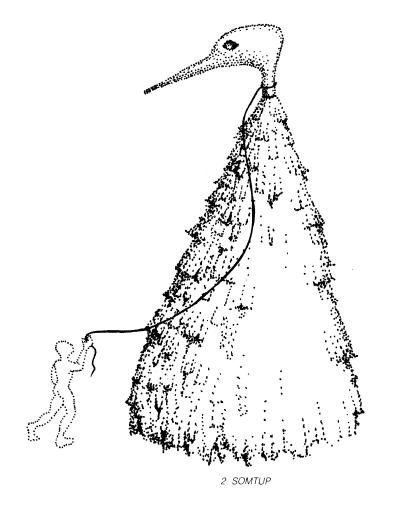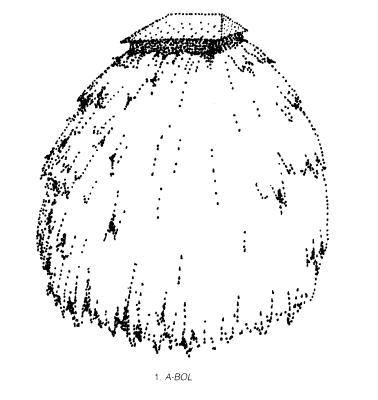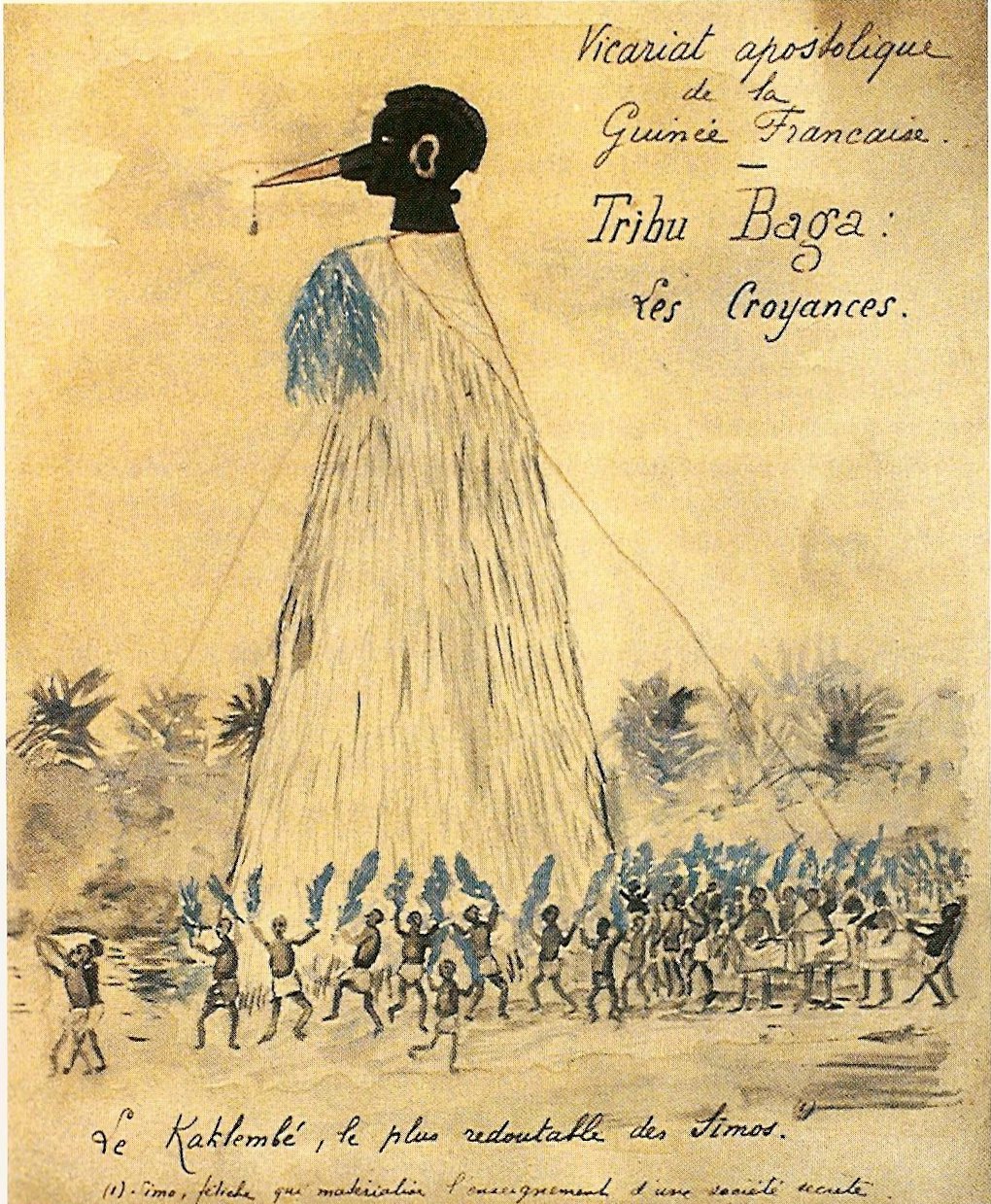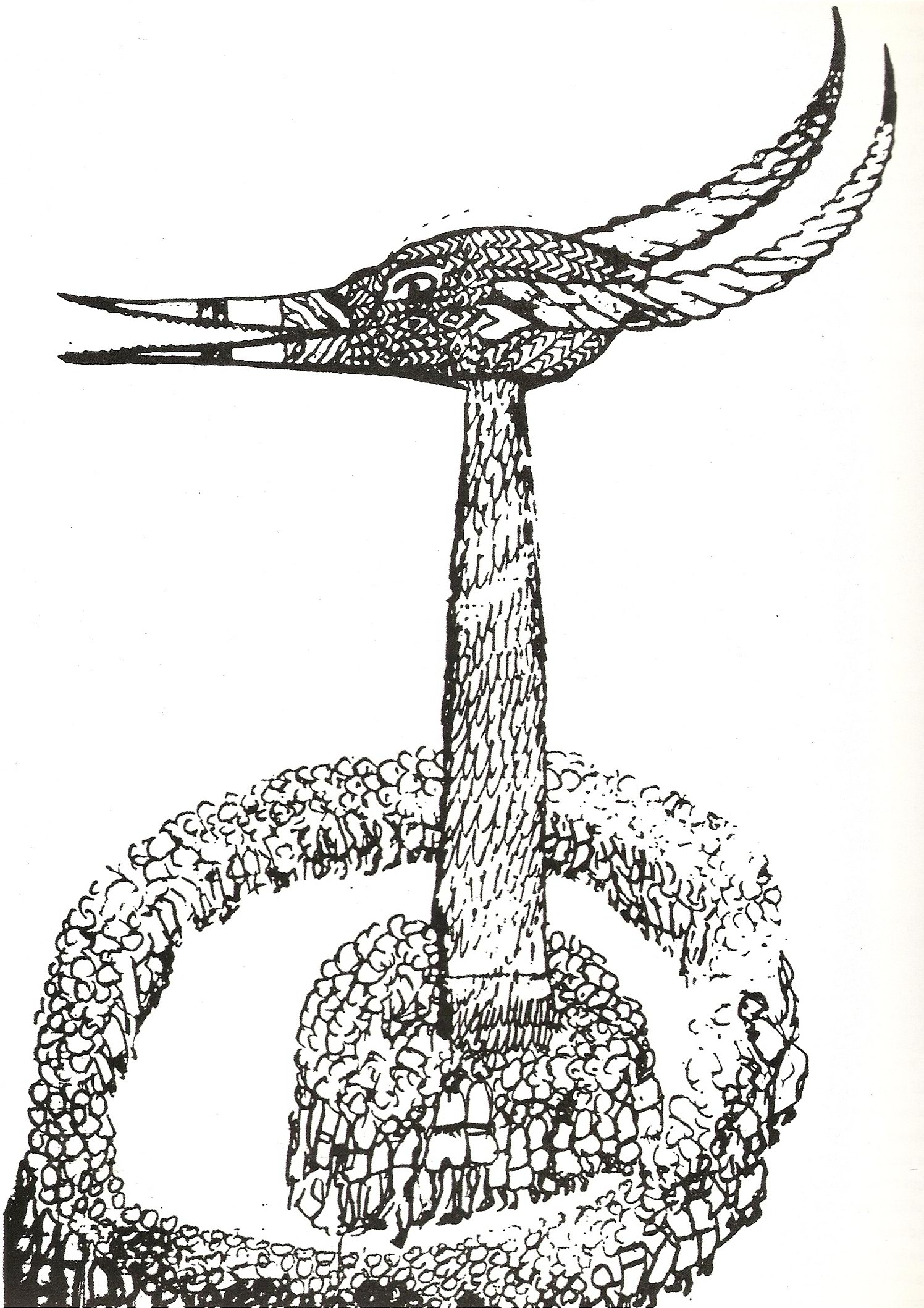kakilambe
Ballets Africains. 1964. Les Ballets africaines (souvenir programme). New York: L. Dunetz and P. Lovett.
(Bagatai)
The Baga Country.
In these days, Kakilambé the terrible God of the Bagas, is no more than a memory which used to make the ancient people tremble . . .
. . . But during centuries he ruled the lives of the Bagatai. He was the master of the waters, of the rain, of the winds and of fire. . . . Every seven years, announced by thunder and the cries of the priests of the great fetish, appeared to the terrified men and through the voice of the Prophet of the Country, he spoke to the assembled villages. First he showed his anger against those whose actions had been contrary to ethics and virtue . . . The people prostrated themselves and repenting, asked him to grant them grace and swore to him allegiance, "Kélyo! Kélyo Kakilambé! Kélyo!" (arise Kakilambé! arise!)
Then Kakilambé, reassured to see that he remained master of the children of the Bagas country as he had been over their fathers before them, roared with joy and predicted seven years of happiness and prosperity, and then, accompanied by songs of joy and gratitude, he disappeared for seven more years . . .
Therefore "during seven years the earth will be prosperous and the women fertile," Kakilambé has spoken. But the prosperity of the earth and the fertility of the women depends on the basic force of the assurance and his devotion to his duty according to the customs. As a beginning to the predictions of Kakilambé the Goddess of fertility appears, NIMBA of the huge breasts, to the shouts of joy of the men and the songs of the women and girls carrying gifts:
O! Nimba! The womb without child
Is like the sand in the wind of the desert
Like the leaf in the fire of the forest.
O! Nimba! Goddess of fertility
O! Nimba! Thou who brings forth fruit from the dust
Here are my breasts, may they be as big as yours
Here is my womb, may it bring forth the children of the Bagatai!
And in a pulsating frenzy, in a complete communion, the men and women of the Bagatai are united, assured of the favor of their Gods.
Lamp, Frederick. 1986. "The Art of the Baga: A Preliminary Inquiry." African Arts 19 (2): 64-67+92.
(Somtup / wu-Them / a-Mantsho-ngö-Pön / a-Paran / Kakilambe)
pp. 65-6
The highest spiritual being recognized by the Baga, after the creator god, Kanu, is the male spirit, Somtup. Alternate names are wu-Them (the Patriarch), a-Mantsho-ngö-Pön2 (the Great Mantsho ["Master" in Manding?]), and a-Paran (the Grandfather). The Susu name for the same spirit is Kakilambe, and this is the term generally given by the Baga when speaking in Susu or French. Somtup was represented in the past by a portable construction (Fig. 2) approximately twenty meters high consisting of a massive cage covered with raffia surmounted by the form of a bird head. The cage was supported underneath by approximately twenty men. This is the spirit of the masculine line. In certain areas of the Baga Sitemu, Somtup is replaced by a similar spirit by the name of Bogäläns. In either case, the initiation society is known by the name of its patron spirit, or by the term to-Lom (the Sacred).

The feminine line is governed by the spirit a-Bol, the wife of Somtup. Her alternate name is u-Thembra (the Matriarch).

Neither of these spirits has ever been illustrated in the literature, and the Baga insist that photography would have been frustrated by the spirits' elusive nature. It is claimed that one researcher attempted to photograph Somtup, but his film recorded nothing. I would be interested to hear from anyone who witnessed the dance of these spirits when they were still extant, as they are no longer represented in dance today.
Under Somtup and a-Bol ranks the spirit a-Mantsho-nga-Tshöl (the Mantsho of Medicine), known alternately by the Susu name of Bansonyi. This is the spirit represented by the tall wooden serpent headdress well known to collectors of Baga art. Although exhibition catalogues often use the Susu term, Kakilambe, interchangeably for this headdress, that term is incorrect, and applies, if one wishes to speak Susu, only to the spirit I have described as Somtup.
(Kakilambé)
p. 215
Nimba et Kakilambé sont les deux grandes divintés bagas. La primière est la déesse de la Fécondité. Elle et représentée par un beau buste de femme avec une tête stylisée, un nez en bec d'aigle et des seins énormes, signe de fécondité. Nimba paraît lors des fêtes de la Moisson. Ce buste que le danseur porte sur les épaules est très lourd ; c'est l'une des sculptures bagas les plus typiques.
Kakilambé, dieu suprême, n'apparaît que tous les 15 ans ou tous les 25 ans ; Kakilambé est un échafaudage ingénieux haut de 20 mètres environ, avec tout au sommet un masque aux yeux de feu.
Lamp, Frederick. 1996. Art of the Baga: A Drama of Cultural Reinvention. New York: Museum for African Art and Prestel Verlag.
(a-Mantsho-ño-Pön / Kakilambe)
p. 57
The very highest male spirit of the Baga, a-Mantsho-ño-Pön, is said to reside in the Fouta still, and to "visit" the coast only every seven years.
The Baga descended from the Fouta Djallon toward the coast with a-Mantsho-ño-Pön (clan elder, Muslim, Tolkotsh, Sitemu, 1992.)
pp. 57–60
All the Baga subgroups address the serpent spirit [. . .]. For the Baga Sitemu and the Pukur, however, another male spirit, who figures prominently in the oral narrative of the descent from the Fouta, is the preeminent one. Among these two northern groups it is the spirit a-Mantsho-ño-Pön, "The Great Mantsho," who holds the highest rank, performing the role that the serpent spirit enjoys elsewhere.
For the Sitemu and the Pukur, a-Mantsho-ño-Pön is the spirit who guided them while they occupied the Fouta Djallon, and he continues to reside there, returning to the Baga only for the initiation of young men. When this ritual was practiced, initiates were personally introduced to him, as a masked dancer, at the end of their initiation, and would not see him again until they became savants. The public, including some non-Baga, were apparently permitted to witness his appearance from afar, but no photographs of the mask were ever taken, and no examples of it have been collected. One living former missionary has told me that he once saw the masquerade, but from such a great distance that he could not distinguish details.
Today, as in the past, Baga elders demand the observance of a code of secrecy about a-Mantsho-ño-Pön. Little is told to the young men, who no longer receive their ritual education in the traditional initiation procedure. This presents the researcher with a dilema. On the one hand, a-Mantsho-ño-Pön is central to social and ritual structure. To discuss initiation, village layout, prohibitions, the migration, and a number of important contemporary masquerades without an elementary understanding of a-Mantsho-ño-Pön would deprive us of some fundamental concepts. On the other hand, one wants to respect the right of exclusive intellectual ownership demanded by the elders. I have therefore decided to present only material that has already been disseminated outside the Baga community, in these, sketches, and collection photographs, together with a minimum of what little elaboration has been offered to my by the elders themselves. I have withheld information that may jeopardize secrecy, and particularly details that outsiders may find abhorrent. What follows, then, is only an elementary introduction to a-Mantsho-ño-Pön—information similar to what any keen observer might have seen and heard when the ritual was current. I beg the indulgence of any elders who may feel I have crossed the line.
The meaning of the name "Mantsho" is unclear. Circumspect about this supreme spirit, Baga consultants seemed not to entertain a traditional etymology. Perhaps the word derives from Mande praise vocabulary, such as the Manding term masa/mansa/mantsha, meaning "chief" or "king," or the Susu word mantoi, "prophet" (Lacan 1942:367). Thus the ful name "a-Mantsho-ño-Pön," combinging the Manding noun with the Baga adjective, would mean "The Great Chief" or "The Great Prophet." A-Mantsho-ño-Pön was also known by several other, more commonly used generic names that will appear in Baga texts:
| "The Grandfather" | Aparan (among the a-Tako) or Aparën (among the a-Bunu) |
| "Teacher of the Ritual Chiefs" | Dusäm-a-Be (Blez Bangoura 1974:52) |
| "The Old Man" | wu-Them/wu-Tem |
| "The Man" | wu-R'kun |
The Susu called this spirit Kakilambe, the name by which he is better known. But this name, meaning "Reaching as high as the copal tree," is problematic, not only because it reflects an outsider's view but because it is frequently confused by the Susu, and thus by Western writers, with another Baga masquerade, that of the serpent headdress a-Mantsho-ña-Tshol [. . .].
On the basis of just a few existing notices and sketches, we can begin to describe a-Mantsho-ño-Pön. An early reference appears to be implied by René Caillié:
Among the peoples who live on the banks of the Rio Nunez there exists a secret society. . . . This society, which has a chief (who is also a magistrate), is known as the Simo. . . . This chief keeps to the woods and remains unknown to those who are strangers to his mysteries. His acolytes are young people who are only partically initiated into his secrets. He assumes various disguises: sometimes he adopts the guise of a pelican. . . .
He comes to the place in disguise, to circumcise the children . . .; the ceremony is accompanied by a great feast, at the expense of the parents, who contribute according to their respective means. The feast lasts sometimes for several days; after it is over, the Simo withdraws to the woods, and takes with him the boys who have been initiated. . . .
On the festival day, the Simo again announces his approach by frightful houwlings, which are imitated by his pupils with cows' horns. They are all armed with whips, in token of their authority. Those who have been formerly initiated, and reside in the neighboring villages, collect and join in the rejoicings (1830:153–55).
In 1885, the French Catholic missionary Jean-Baptiste Raimbault, based at the Rio Pongo, described a similar image in his description of the Boffa area, suggesting that the Baga Kakissa may also have had the masquerade of a-Mantsho-ño-Pön:
The ordeal [of male initiation] terminated, the chief makes the [initiate] eat the Simo. He conducts him in front of a scaffolding surmounted by a head of wood, to which he poses the following questions: "Simo (he calls in this way the spirit who is supposed to reside inside the ido), do you wish to receive among us the said person here?" At each question the head responds by a sign of assent, and it strikes up an infernal racket throughout the entire structure (1885:60).
This corresponds closely to a Sitemu initiation ritual (described in a later chapter) in which a-Mantsho-ño-Pön is said to "tremble" and "shake," to answer inquiries from his ritual practitioners with a shrill whistle, and to see what is going on around him with his entire body.
Early reports from the French Catholic mission at Katako detailed the a-Mantsho-ño-Pön masquerade there:
Kaklembé [Kakilambe] is a fetish that often reaches ten meters high: it is composed of a mobile scaffolding carried by ten or fifteen men, hidden under a costume of garish fabrics and palm leaves. The idol terminates in the head of a bird: at its upper part is fitted a sort of cage where an initiated person sits. This brotherhood lets loose dismal screams which are supposed to come from the fetish itself. The procession of this fetish takes place approximately once every ten years. Any noninitiate who would dare to watch would immediately be put to death. Also, the women and children crouch down deeply in their houses when Kaklembé emerges from the sacred forest to promenade in the village (Voix, IV, 3, 1929:15.)
Père Feuillet actually found himself face to face with "Kaklembé." . . . The scaffolding—because it is a veritable ambulant scaffold—is carried by about ten men hidden under a costume of fibers and dried leaves. I believe truly that "Kaklembé" is one of the most terrible fetishes. . . . I recall that he sketched it on a piece of paper (Voix, V, 7, 1930:14).
A few sketches exist that help us to envision the grand spectacle that was a-Mantsho-ño-Pön. The most revealing one was done in watercolor or ink, probably before 1930, by an anonymous Catholic missionary of the Pères du Sainte-Esprit. No one at the mission at Katako today, where the sketch must have been executed, knows who might have drawn it, but it was most likely the above-mentioned Père Feuillet. The drawing now lies in the archives of the Pontificio Museo Missionario Ethnologico, in the Vatican. Several sketches of other Baga masquerades accompany it, and these other pictures, unlike the a-Mantsho-ño-Pön drawing, can be compared with photographs of the relevant masquerades from the same period; they are all quite inaccurate. It should be assumed, then, that the sketch of a-Mantsho-ño-Pön also contains inaccuracies. Much of the detail, however, was confirmed by our consultants.

40. "Kakilambé, the most fearsome of the Simos." By a Catholic missionary of the Pères du Saint-Esprit, probably Père Feuillet, before 1930. Kakilambé or a-Mantsho-ño-Pön (as the Baga call him) was the supreme male spirit of the Sitemu subgroup, and is said to reside still in the Fouta Djallon. Watercolor. Courtesy the Pontificio Museo Missionario Ethnologico, Vatican City.
Writing in 1932, Carl Kjersmeier recalled his own search for the headdress, aided by a sketch that was probably the same watercolor now in the Vatican:
We did not see . . . the largest of all Baga masks, Kaklembe, which is fifteen meters high and resembles a tower. At its top sits a man who calls out a warning to all not initiated; they must stay away. It sees understandable that we did not see anything of this giant mask, which must be carried by about twenty men. It is only in use every fourteen years and the younger generation of Baga has never seen it. I brought along a drawing of Kaklembe and everywhere it was studied with the greatest interest (1932:199–200).
Only one sketch (fig. 41) has ever been published: that of Paulme's consultant at Monchon (1962:67). Paulme apparently failed to catch its significance, simply labelling it "Baga mask, Guinea," with no reference to it in her text, and no indication of whether it illustrated a masquerade of the Monchon Buluñits or of another group. The Buluñits have a close relationship with the Pukur, and are privy to Pukur ritual, so it is reasonable to imagine that a Buluñits youth might have seen the Pukur spirit. On the other hand, testimony is ambiguous as to whether the Buluñits actually had their own version of this towering beaked eminence.

41. Sketch of the supreme male spirit, probably Pukur, by Moussa Bangoura, a Buluñits youth from Monchon Village. This is the only previously published illustration of this masquerade, drawn for Denise Paulme by her consultant at Monchon. Courtesy Denise Paulme.
The appearance of a-Mansho-ño-Pön was terrifying for all but the elder savants, and particularly for the uninitiated. Consultants often spoke of his function in helping the Baga to maintain their control over the coastal region, terrorizing outsiders who posed a risk to them, such as the Susu or the Fulbe. Thus allegiance to a-Mansho-ño-Pön defined identity in positive and negative, inclusive and exclusive ways.
p. 63
Though the spirit is almost unhead of outside Baga circles, it—more than any other Baga spirit manifestation—is a source of Baga self-image in relation to other ethnic groups, other Baga tribes, other clans of gendered alliance, and other generations of Baga confrères. A-Manstsho-ño-Pön embodies the deep sense of Baga heritage seen in the tradition of the common descent from Fouta.
p. 65
For the Baga Sitemu and the Pukur, male moieties are aligned with the monumental bird masquerade a-Mantsho-ño-Pön (Somtup or Böglänsh), femaile moieties with a female high spirit, a-Bol.
p. 120
The adults, because they are a-di-a-Mantsho [-ño-Pön] ["those who have 'eaten' a-Mantsho"—have "swallowed" the ordeal of initiation], i.e., those initiated to the secrets of Kakilambé . . . are privy to numerous, profound secrets which they cannot reveal (Blez Bangoura 1974:21).
p. 261
Kakilambe - (Su) = a-Mantsho-ño-Pön. Kaki is the name of a tall tree (gomme copal); lambe means "to climb"; thus something that ranges as tall as the Kaki tree
p. 262
a-Mantsho-ño-Pön - highest male spirit, twenty-meter-high raffia costume with bird head at top; husband of a-Bol
Bangoura, M'Bemba. 1996. Wali. Somadisc002.
(Kakilambé)
The Baga people of Lower Guinea call the mask that protects the sacred forest "Kakilambe".
Billmeier, Uschi. 1999. Mamady Keita: A Life For the Djembe—Traditional Rhythms of the Malinke. Engerda, Germany: Arun-Verlag.
(Kakilambe)
Traditional Ethnic Group: Baga; West Guinea, Boke Region
Kakilambe is an important mask of the Baga, and it appears only once a year. The spirit of Kakilambe is revered as the protector against evil spirits. He appears to make important revelations about the present and the future. A priest of Kakilambe functions as the mask's interpreter, because the mask does not speak directly to the people.
It is a big day when the mask appears. Everybody comes to listen. Slowly, the mask emerges from the forest, along with its priests. The people have gathered and are waiting. When all the people bow, the mask grows to a height of five meters! Ropes are attached to the mask, one for each individual family of the village, and the other end of each rope is held by a member of each family.
When the rhythm gets fast, the priests and some of the older men dance around the mask. The mask and the rhythm is played slower and softer. Meanwhile, he gives the people the information that was given to him by the mask; for instance, whether there will be a drought, or a flood, whether the rice harvest will be good, and so on. He also will tell whether the children will be in good health, whether the men will behave well, and finally, he tells the people the sacrifices that each one must make.
Charry, Eric. 2000. Mande Music: Traditional and Modern Music of the Maninka and Mandinka of Western Africa. Chicago; London: University of Chicago Press.
(Kakilambe)
p. 22
Baga rhythms such as Sorsorne and Kakilambe (the Susu term for the highest Baga deity) have entered into the repertory of the national ballets, . . .
Delbanco, Åge. 2012. West African Rhythms. Charleston, SC: Seven Hawk.
(Kakilambé)
Kakilambe is a mask of the Baga people from the Boke region in Guinea.